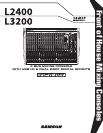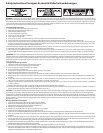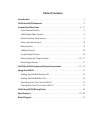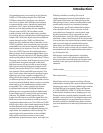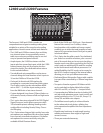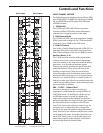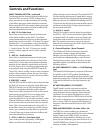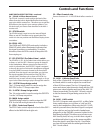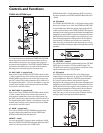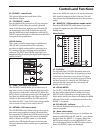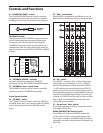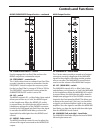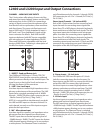
4
Controls and Functions
5
INPUT CHANNEL SECTION - continued
That means that the channel Fader also affects the
level of a POST aux send. A POST Auxiliary bus is
what you want to use (almost always) for sending
to an effects processor, either internal or external.
When using the POST aux sends, (while turning the
channel Fader up or down) the level of effects will
track the channel level correctly.
4 – AUX 1-2 Pre Fader Send
Each of the L series’ input channels include a pair
of Pre Fader Auxiliary sends; AUX 1-2 and their
control knobs adjust the amount of that channel’s
signal that is sent to the AUX 1-2 Output. The signal
feeding AUX 1-2 is sent before, or pre, the channel
Fader, so the channel Fader has no effect on the AUX
1-2 output levels. The AUX 1-2 busses are usually
used to create a separate mix for a floor monitor
system.
5 – AUX 3-4 – Pre/Post Fader
Each of the L series’ input channels include a pair
Auxiliary sends which can switch from Pre to Post
sends; AUX 3-4 and their control knobs adjust the
amount of that channel’s signal that is sent to the
AUX 3-4 Output. Aux 3-4 can be configured for pre
or post fader send using the PRE/POST switch (6).
The AUX 3-4 bus is usually used to create a separate
mix for a floor monitor system, but you can set the
Pre/Post switch to Post to use the send as en effects
bus to an external processor.
6- PRE/POST - switch
The PRE/POST switch is used to select the point that
the AUX 3-4 bus uses to send the signal. When the
PRE/POST switch is set to PRE, the signal feeding
AUX 3-4 is sent before the fader, so the channel
Fader has no effect on that level. This is the normal
setting when using AUX 3-4 as a monitor send.
When the PRE/POST switch is set to POST, the
signal feeding AUX 3-4 is sent after the fader, so the
channel Fader has an effect on that level, meaning
the Aux level tracks up and down with the channel
Fader. This is the normal setting for using AUX 3-4
as an effects send, since when you set the channel
loude,r you normally want the effect to get louder.
Channel Fader up or down the level of effects will
track the channel level correctly.
7 – EFX1-2 / AUX 5-6 - Post Fader Send
The L series provide high quality, 24 Bit digital
effects, and the level of effects can be set
6
7
independently on each channel. The channel’s EFX1-
2 knob controls the amount of signal that is sent to
each the two EFX bus feeding the two internal DSP
effect processors. For additional flexibility, the EFX1-
2 signal can also be sent to an external effect device
connected to the AUX 5-6 Output jacks located on
the rear panel jack field.
8 – AUX 5-6 - switch
The AUX 5-6 switch is used to select the point that
the EFX1-2 / AUX 5-6 uses to send the signal. When
a channel’s AUX 5-6 switch is set to on (down), the
signal from that channel is routed to the AUX 5-6
bus. This separate mix can be sent to an external
effect device connected to the AUX 5-6 jacks located
on the rear panel jack field.
9 - Channel Equalizer - Mono Channels
The L2400 and L3200 mic/line input channels
incorporate a 3-band, swept-mid equalizer
allowing you to adjust the high, mid-range, and
low frequencies independently on each channel.
The frequency centers, range of boost or cut, and
equalizer type for each band are described in the
following section:
HF (HIGH FREQUENCY) 12kHz +/- 15dB Shelving
type
The channel’s HIGH frequency response is flat when
the knob is in the “12:00” position. Rotating the
knob towards the right will boost the channel's high
frequency response at 12 kHz by 15dB, and rotating
it towards the left will cut the high frequency by
15dB.
MF (MID FREQUENCY) CUT & BOOST
The MF knob is used in conjunction with the
FREQ knob to create the tonal shape in the mid-
range frequency when using the mono channel’s
equalizers. You can adjust the frequency on the
mid-range control with the FREQ knob, and use the
MF control to either boost or cut that frequency by
plus or minus 15dB. The channel’s MID frequency
response is flat when the MF knob is in the “12:00”
position.
FREQ (MID FREQUENCY) Variable 100Hz – 8K
The FREQ is a control enabling you enhanced
capabilities in the tonal shaping of the input channel
signal. Thanks to the FREQ control, you have a
variable mid-range equalizer, allowing you to pin
point the exact frequency you want to boost or cut.
The MID SWEEP has a “fixed Q” of two octaves (the
amount, or width, of frequencies



